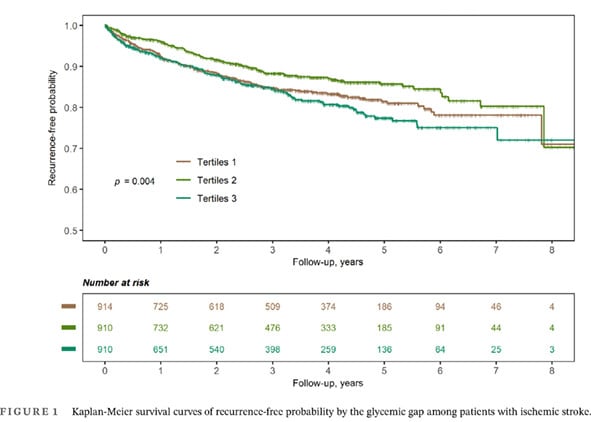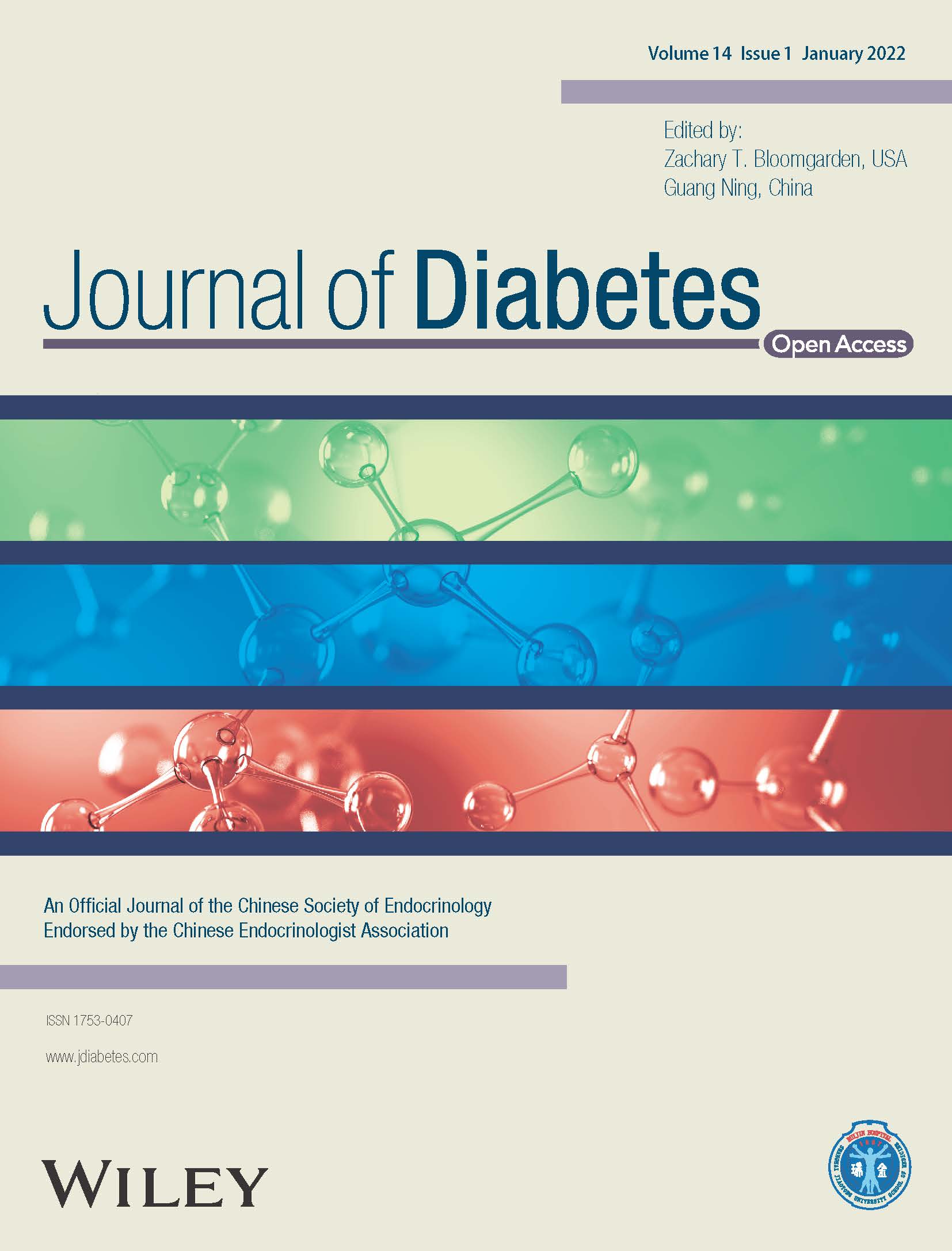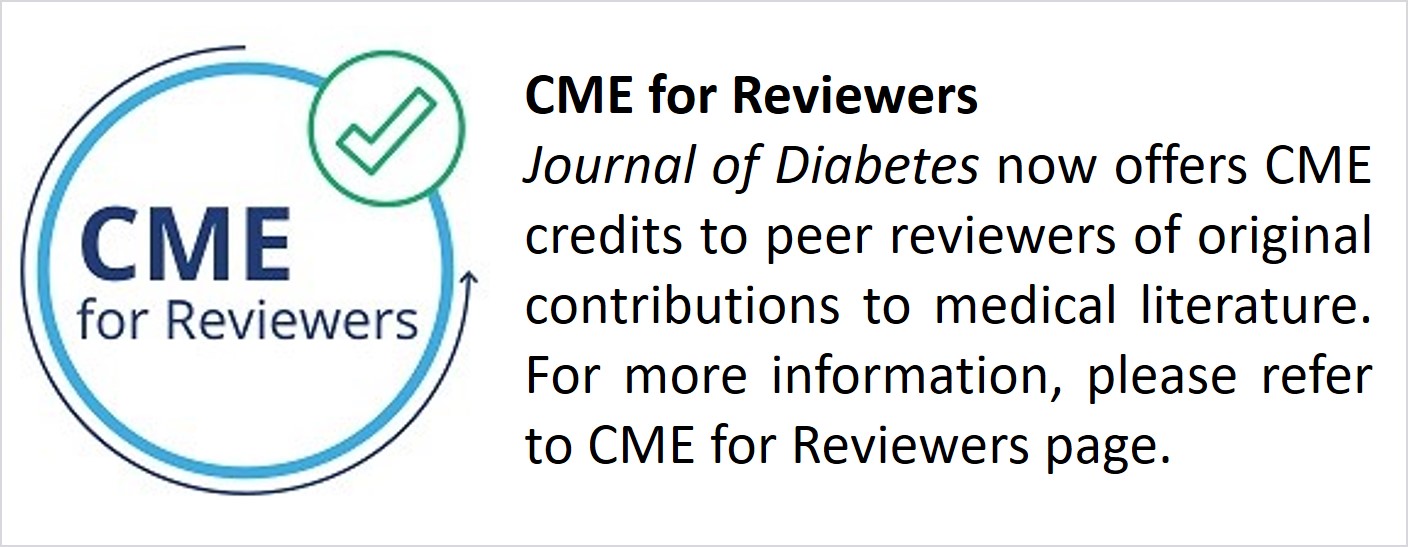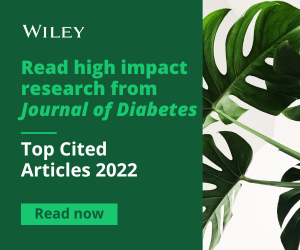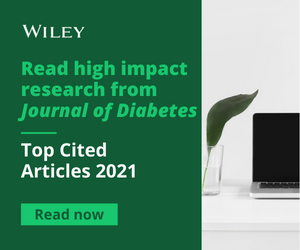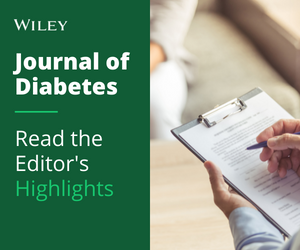Edited By: Zachary T. Bloomgarden and Guang Ning
Journal list menu
Journal of Diabetes (JDB) is an open access diabetes and metabolism journal devoted to diabetes research, therapeutics, and education. The journal aims to involve researchers and practitioners in a dialogue between East and West via all aspects of epidemiology, etiology, pathogenesis, management, complications and prevention of diabetes, including the molecular, biochemical, and physiological aspects of diabetes. JDB is an official journal of the Chinese Society of Endocrinology endorsed by the Chinese Endocrinologist Association.
Announcement

Journal of Diabetes has changed to a fully open access journal since 2022. Work published benefits from greater visibility, higher downloads, and more citations.
All submissions received will be subject to an Article Publication Charge (APC) if accepted and published, unless a waiver is applied. Journal of Diabetes does not charge submissions fees. For more information on the fees, please click here.
Articles
Clinical investigation of glucokinase activators for the restoration of glucose homeostasis in diabetes
- 25 April 2024
Graphical Abstract

Highlights
Gamma‐glutamyl transferase and the risk of all‐cause and disease‐specific mortality in patients with diabetes: A nationwide cohort study
- 25 April 2024
Graphical Abstract

Highlights
Cost saving analysis of prediabetes intervention modalities in comparison with inaction using Markov state transition model—A multiregional case study
- 25 April 2024
Graphical Abstract

Highlights
Acellular fish skin grafts in the treatment of diabetic wounds: Advantages and clinical translation
- 25 April 2024
Graphical Abstract

Highlights
The metabolic effects of habitual leg shaking: A randomized crossover trial
- 25 April 2024
Graphical Abstract

Highlights
Continuous subcutaneous insulin infusion versus multiple daily injection therapy in pregnant women with type 1 diabetes
- 25 April 2024
Graphical Abstract

Highlights
Epidemiology of type 1 diabetes mellitus in children and adolescents: A 50‐year, single‐center experience
- 25 April 2024
Graphical Abstract

Highlights
Prevalence of nonalcoholic fatty liver disease and liver cirrhosis in Chinese adults with type 2 diabetes mellitus
- 25 April 2024
Graphical Abstract

Highlights
The association between sodium glucose cotransporter‐2 inhibitors vs dipeptidyl peptidase‐4 inhibitors and renal outcomes in people discharged from hospital with type 2 diabetes: A population‐based cohort study
- 10 April 2024
Graphical Abstract

Highlights
This was the first Australian study using real-world data to show SGLT-2is reduce ARF and CKD compared to DPP-4is in people with type 2 diabetes. The rates of hospital admissions for ARF and CKD in people with type 2 diabetes were 22% and 17% lower, respectively, among SGLT-2i initiators compared to DPP-4i initiators.
Our study suggests that benefits of SGLT-2is apparent in clinical trials, in preventing acute and chronic renal events in people with type 2 diabetes, are reflected in real-world clinical practice.
Time‐limited diets and the gut microbiota in cardiometabolic disease
- Journal of Diabetes
- 377-393
- 13 June 2022
Graphical Abstract

Highlights
Global prevalence of prediabetes in children and adolescents: A systematic review and meta‐analysis
- Journal of Diabetes
- 434-441
- 5 July 2022
Graphical Abstract
Increased neutrophil count Is associated with the development of chronic kidney disease in patients with diabetes
- Journal of Diabetes
- 442-454
- 4 July 2022
Increased incidence of childhood type 1 diabetes during the COVID-19 pandemic. Figures from an Italian tertiary care center
- Journal of Diabetes
- 562-563
- 2 August 2022
Electroacupuncture reduces blood glucose by regulating intestinal flora in type 2 diabetic mice
- Journal of Diabetes
- 695-710
- 4 October 2022
Follow‐up frequency and clinical outcomes in patients with type 2 diabetes: A prospective analysis based on multicenter real‐world data
- Journal of Diabetes
- 306-314
- 25 May 2022
Graphical Abstract

Highlights
Health utilities in Chinese patients with coronary heart disease and impaired glucose tolerance (ACE): A longitudinal analysis of a randomized, double-blind, placebo-controlled trial
- Journal of Diabetes
- 455-464
- 25 July 2022
Graphical Abstract

Highlights
Impact of SARS-CoV2 on youth onset type 2 diabetes new diagnoses and severity
- Journal of Diabetes
- 532-540
- 20 August 2022
Graphical Abstract

Highlights
Nonalcoholic fatty liver disease in relation to the remission and progression along the glycemic continuum
- Journal of Diabetes
- 606-619
- 26 September 2022
Graphical Abstract

Highlights
Metformin and growth differentiation factor 15 (GDF15) in type 2 diabetes mellitus: A hidden treasure
- Journal of Diabetes
- 806-814
- 28 November 2022
Graphical Abstract

Highlights
Mechanisms of diabetic foot ulceration: A review
- Journal of Diabetes
- 299-312
- 9 March 2023
A novel simple disposition index (SPINA-DI) from fasting insulin and glucose concentration as a robust measure of carbohydrate homeostasis
- Journal of Diabetes
- 2 January 2024
Use of basal insulin in the management of adults with type 2 diabetes: An Asia-Pacific evidence-based clinical practice guideline
- Journal of Diabetes
- 474-487
- 23 April 2023
The impact of health literacy interventions on glycemic control and self‐management outcomes among type 2 diabetes mellitus: A systematic review
- Journal of Diabetes
- 724-735
- 5 July 2023
Is metformin a possible treatment for diabetic neuropathy?
- Journal of Diabetes
- 658-669
- 18 September 2022
Effectiveness, safety, initial optimal dose, and optimal maintenance dose range of basal insulin regimens for type 2 diabetes: A systematic review with meta‐analysis
- Journal of Diabetes
- 419-435
- 10 April 2023
Mechanisms of bariatric surgery for weight loss and diabetes remission
- Journal of Diabetes
- 736-752
- 13 July 2023
Osteoarthritis and risk of type 2 diabetes: A two-sample Mendelian randomization analysis
- Journal of Diabetes
- 987-993
- 31 July 2023
Patient experiences of continuous glucose monitoring and sensor‐augmented insulin pump therapy for diabetes: A systematic review of qualitative studies
- Journal of Diabetes
- 1048-1069
- 8 August 2023
Metformin and growth differentiation factor 15 (GDF15) in type 2 diabetes mellitus: A hidden treasure
- Journal of Diabetes
- 806-814
- 28 November 2022
Recent issues
- Volume 16, Issue 5May 2024
- Volume 16, Issue 4April 2024
- Volume 16, Issue 3March 2024
- Volume 16, Issue 2February 2024





